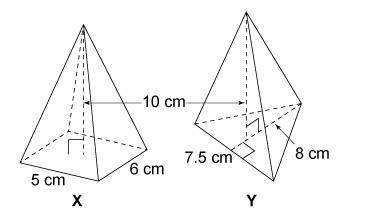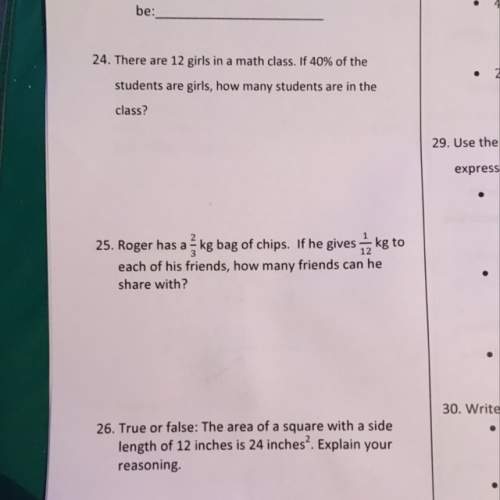
Mathematics, 05.05.2020 10:07 madisonelizibet1
Jeremy is given the choice between two chocolates, X and Y. Which one should he choose to get the most chocolate possible, and how much more chocolate does he get by picking the larger one?
Two pyramids. The rectangular pyramid has base 5 centimeters by 6 centimeters and height 10 centimeters. The triangular pyramid also has height 10 centimeters. The triangular base is 7.5 centimeters across the bottom and 8 centimeters tall.
A. It does not matter. The volumes of X and Y are equivalent.
B. He should choose Y, since he will get twice as much chocolate.
C. He should choose X, since he will get twice as much chocolate.
D. He should choose X, since he will get 10 times as much chocolate.


Answers: 3
Another question on Mathematics

Mathematics, 21.06.2019 17:00
Use the expression below.–4b + 8c + 12 – 8b – 2c + 6part asimplify the expression. enter your answers in the boxes. b + c + part bfactor the simplified expression using the gcf. a. 2(–2b + c + 3) b. 3(–2b + c + 3) c. 4(–2b + c + 3) d. 6(–2b + c + 3)part cwhat is the value of the expression when b = 2 and c = –3? enter your answer in the box.
Answers: 1

Mathematics, 21.06.2019 18:30
Ill mark the brainliest if you me with the these three questions 7,8,9
Answers: 2

Mathematics, 21.06.2019 21:30
In a test for esp (extrasensory perception), the experimenter looks at cards that are hidden from the subject. each card contains either a star, a circle, a wave, a cross or a square.(five shapes) as the experimenter looks at each of 20 cards in turn, the subject names the shape on the card. when the esp study described above discovers a subject whose performance appears to be better than guessing, the study continues at greater length. the experimenter looks at many cards bearing one of five shapes (star, square, circle, wave, and cross) in an order determined by random numbers. the subject cannot see the experimenter as he looks at each card in turn, in order to avoid any possible nonverbal clues. the answers of a subject who does not have esp should be independent observations, each with probability 1/5 of success. we record 1000 attempts. which of the following assumptions must be met in order to solve this problem? it's reasonable to assume normality 0.8(1000), 0.2(1000)%30 approximately normal 0.8(1000), 0.2(1000)% 10 approximately normal srs it is reasonable to assume the total number of cards is over 10,000 it is reasonable to assume the total number of cards is over 1000
Answers: 1

Mathematics, 21.06.2019 23:00
According to a study conducted in 2015, 18% of shoppers said that they prefer to buy generic instead of name-brand products. suppose that in a recent sample of 1500 shoppers, 315 stated that they prefer to buy generic instead of name-brand products. at a 5% significance level, can you conclude that the proportion of all shoppers who currently prefer to buy generic instead of name-brand products is higher than .18? use both the p-value and the critical-value approaches.
Answers: 1
You know the right answer?
Jeremy is given the choice between two chocolates, X and Y. Which one should he choose to get the mo...
Questions

Mathematics, 27.01.2021 16:30



Mathematics, 27.01.2021 16:30






Mathematics, 27.01.2021 16:30



Mathematics, 27.01.2021 16:30



Health, 27.01.2021 16:30

History, 27.01.2021 16:30

Mathematics, 27.01.2021 16:30






